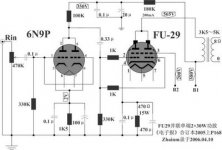Hi guys
I found this schematics for an "alleged" single-ended triode amp based on the FU-29 tube. The schematics is fairly simple and claimed to produce a healthy 30 W output. Since the tube is cheap and the circuit looked straightforward, I am very tempted to give it a shot. For all your tube amp jocks out there, please comment on the schematic and do you feel that this thing would/might work. One thing that I was puzzled is that one of the grid of the fu-29 is hooked up to a 200 v rail - does it really work as a triode?
Well, I have to find out the requirement of the OPT and somehow figure out the PS section. Any suggestions and comments will be much appreciated by this newbie.
Allan
I found this schematics for an "alleged" single-ended triode amp based on the FU-29 tube. The schematics is fairly simple and claimed to produce a healthy 30 W output. Since the tube is cheap and the circuit looked straightforward, I am very tempted to give it a shot. For all your tube amp jocks out there, please comment on the schematic and do you feel that this thing would/might work. One thing that I was puzzled is that one of the grid of the fu-29 is hooked up to a 200 v rail - does it really work as a triode?
Well, I have to find out the requirement of the OPT and somehow figure out the PS section. Any suggestions and comments will be much appreciated by this newbie.
Allan
Attachments
I suggest you find a less ambitious first amp...
585VDC @ 200ma implies a supply capable of blowing you into the middle of next week - if you are lucky.
Putting aside the cost of iron for the project, and my personal doubts that you could acheive 30W output, it has significant potential for making your wife a widow.
585VDC @ 200ma implies a supply capable of blowing you into the middle of next week - if you are lucky.
Putting aside the cost of iron for the project, and my personal doubts that you could acheive 30W output, it has significant potential for making your wife a widow.
I think, without cathode shunts 0.1 uf in two stages, sound will be better, practicaly /I tried/, You will lose Hi Freequence, instead increase it, because signal will
across two different cap media with different spead and sound will be "closed" on Hi Freeq. For best result You can use electr. caps Black gain or ELNA Cerafine. I never use two different shunt caps.....But You will decide.../Maybe tube is GU29?/.
across two different cap media with different spead and sound will be "closed" on Hi Freeq. For best result You can use electr. caps Black gain or ELNA Cerafine. I never use two different shunt caps.....But You will decide.../Maybe tube is GU29?/.
You're more likely to get 12W or so at best. And the source impedance will be really high, i.e. fractional damping. That will definitely give you a VERY non-flat frequency response unless your speakers are designed for current drive (which they almost certainly aren't). Triode it is not.
Gentlemen,
Thank you very much for all the comments and advices. Much appreciated. I guess my hunches were correct that this circuit is not a SET amp. The power output was also way inflated (thanks SY) - I am going to search for better alternatives. Thanks agains, guy!
Lo-tse
Thank you very much for all the comments and advices. Much appreciated. I guess my hunches were correct that this circuit is not a SET amp. The power output was also way inflated (thanks SY) - I am going to search for better alternatives. Thanks agains, guy!
Lo-tse
- Status
- This old topic is closed. If you want to reopen this topic, contact a moderator using the "Report Post" button.
